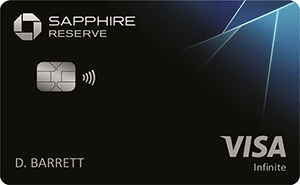The Guide to Chase Sapphire Reserve’s Car Rental Insurance
The Sapphire Reserve stands out among travel cards for providing primary rental car insurance coverage.

Many or all of the products on this page are from partners who compensate us when you click to or take an action on their website, but this does not influence our evaluations or ratings. Our opinions are our own.
No one ever wants to experience an auto collision or a stolen car, least of all when driving a rental while on vacation. Thankfully, having good auto rental insurance coverage can help take some of the sting out of any vehicular adversity you might have on the road.
While many credit cards offer car rental insurance to varying degrees, having Chase Sapphire Reserve® car rental insurance often negates the need to purchase additional coverage entirely.
That said, it’s important to know how the insurance policy works, what it does and doesn’t cover and how to file a claim if necessary. Here are four things to know about your Chase Sapphire Reserve® car rental insurance.
1. What does Chase Sapphire Reserve® car rental insurance cover?
Unlike coverage offered by some other travel credit cards, the car rental insurance that’s offered with your Chase Sapphire Reserve® card is primary coverage, not secondary. That means you don’t have to report the incident to your personal auto insurance company.
Most cards with secondary coverage require you to file a claim with your personal auto insurance first; you can then file with card benefit services to cover whatever is left. Not so with the Chase Sapphire Reserve®: if the damage is covered, you can leave your personal coverage out of it.
As for what your Chase Sapphire Reserve® does cover: up to $75,000 in reimbursement for theft and collision damage, as well as applicable loss-of-use charges, administrative fees, and towing charges. The policy covers most rental vehicles booked and paid for in full with your Chase Sapphire Reserve®, whether you’re renting in the U.S. or abroad.
» Learn more: Reasons why you need a Chase Sapphire Reserve® card
2. Who is covered?
If you need to file a claim, keep in mind that only you, as the primary driver, are covered, plus any other drivers authorized by the rental car agreement.
So if there’s any chance a spouse, friend or family member might get behind the wheel, add their names to the rental agreement to ensure they’re also covered if anything happens.
» Learn more: The guide to Chase Sapphire rental car insurance
3. What’s not covered?
Not all rental vehicles are covered by your Chase Sapphire Reserve®’s auto rental coverage. Here are a few vehicles that are not covered by the policy:
Antique cars.
Cargo vans.
Trucks other than pickups.
Motorcycles and mopeds.
Limousines.
Recreational vehicles.
Passenger vans seating ten or more people, including the driver.
Chase’s car rental insurance also doesn’t offer coverage of the following:
Damage to other drivers’ vehicles.
Medical bills for injuries sustained by you or other passengers.
Damage to any goods inside the vehicle, whether due to damage or theft.
Incidents or damage caused by off-road adventures.
Rental periods that are longer than 31 days.
Any incident where the driver was driving under the influence of drugs or alcohol or participating in illegal activities.
» Learn more: How to find the best travel insurance
4. How to file a claim for car rental insurance
If you must file a claim at some point, it’s important to know how to proceed, starting at the check-in counter. First, when you review and sign the rental car agreement, make sure to decline the car rental company’s collision damage waiver. If you opt in, it will cancel out your credit card’s auto rental collision benefit.
Then, if theft or damage occurs during your trip, call your card’s benefit administrator as soon as possible after the event to report it (the number is on the back of your card).
You’ll also need to gather copies of several documents to support your claim:
The accident report.
The rental agreement.
The repair estimate and itemized bill.
Two photos of the damage, if applicable.
A police report if at all possible.
A demand letter listing the costs you’re responsible for and any amounts you’ve already paid toward the claim.
Send all of these documents to the benefit administrator, along with the Auto Rental Collision Damage Waiver claim form and the credit card account statement showing the rental transaction. Chase recommends filing your claim online at www.eclaimsline.com to make the process as fast and easy as possible.
You’ll have 100 days to report any theft or damage after the incident, 120 days to send in the claim form and 365 days to submit all necessary documentation. But the sooner you file and send everything, the sooner you’ll be reimbursed for any covered expenses.
Chase car rental insurance, recapped
Using a card like the Chase Sapphire Reserve® to pay for your car rental is a savvy way to not only earn valuable Ultimate Rewards® points, but also score coverage for auto rentals.
It can cover costs for damage to or theft of the car without getting your personal car insurance involved.
How to maximize your rewards
You want a travel credit card that prioritizes what’s important to you. Here are some of the best travel credit cards of 2025:
Flexibility, point transfers and a large bonus: Chase Sapphire Preferred® Card
No annual fee: Wells Fargo Autograph® Card
Flat-rate travel rewards: Capital One Venture Rewards Credit Card
Bonus travel rewards and high-end perks: Chase Sapphire Reserve®
Luxury perks: The Platinum Card® from American Express
Business travelers: Ink Business Preferred® Credit Card
Chase Sapphire Preferred® Card
Travel
Dining
🔥 Huge highest-ever bonus on NerdWallet's 2025 Best All-Purpose Travel Rewards Card is back. Don't miss your rare chance to: Earn 100,000 points when you spend $5,000 on purchases in the first three months. That's worth at least $1,250 toward travel booked through Chase.



